
Supersonic travel, once heralded as the future of aviation, saw its heyday in the latter half of the 20th century. The iconic Concorde captured the imagination of travelers and aviation enthusiasts alike, offering a unique experience that transcended traditional flight. However, as quickly as it rose to fame, supersonic travel fell from grace due to a myriad of challenges. In this article, we will explore the history of supersonic travel, the factors that led to its decline, and whether we are on the cusp of a new era of fast air travel.
1. The Origins of Supersonic Travel
The concept of supersonic travel emerged during World War II when advancements in aerodynamics and jet engine technology opened new possibilities for aviation. The first successful supersonic flight occurred in 1947 when test pilot Chuck Yeager broke the sound barrier in the Bell X-1 aircraft. This groundbreaking achievement laid the groundwork for future commercial supersonic jets.
The most famous of these jets was the Concorde, which made its maiden flight in 1969 and commenced commercial operations in 1976. Able to cruise at speeds of over twice the speed of sound (Mach 2), the Concorde drastically reduced travel times, cutting the London to New York flight duration to just under three and a half hours.
2. The Golden Age of Concorde
The Concorde became a symbol of luxury and technological prowess. Frequent fliers enjoyed premium travel, complete with fine dining and exclusive amenities. Celebrities and business moguls sought out Concorde for its speed and opulence, and airlines like British Airways and Air France established dedicated routes for this iconic aircraft.
However, it wasn’t just luxury that the Concorde offered; it was a remarkable feat of engineering. With a cruising altitude of 60,000 feet, passengers could see curvature of the Earth, making the flight an unforgettable experience.
3. Challenges and Decline
Despite its glamour, supersonic travel faced significant hurdles. One of the main issues was the sonic boom produced when flying faster than the speed of sound. This phenomenon created a loud noise that could be heard on the ground, leading to restrictions on where supersonic flights could operate. Additionally, fuel consumption and environmental concerns regarding noise and emissions began to tarnish the Concorde’s reputation.
The tragic accident of Air France Flight 4590 in 2000 further accelerated the decline of supersonic travel. The Concorde fleet faced growing maintenance costs, and airlines struggled to justify the high ticket prices required to operate the aircraft profitably. In 2003, British Airways and Air France announced the retirement of the Concorde, marking the end of commercial supersonic travel.
4. The Revival of Supersonic Dreams
Despite the setbacks, interest in supersonic travel has resurfaced in recent years. Advances in technology and increased focus on sustainability have sparked new endeavors to introduce supersonic jets that address previous challenges. Several companies, including Boom Supersonic and Aerion, are working on developing next-generation supersonic aircraft that promise to be more efficient, environmentally friendly, and quieter than their predecessors.
Boom Supersonic, for instance, is developing the Overture, a supersonic airliner designed to carry 65 to 88 passengers at speeds of Mach 1.7. With plans to operate transcontinental routes, Overture is aimed at reconnecting travelers who want to spend less time in transit and more time at their destination.
5. The Technological Innovations
The new wave of supersonic aircraft aims to incorporate advanced materials and technologies to mitigate the noise of sonic booms. A notable approach involves designing aircraft with a “boomless” cruise, allowing them to fly faster than sound over land without disturbing those below.
Moreover, today’s jets are being engineered with improved aerodynamics and fuel efficiency. These innovations could potentially alleviate the regulatory concerns that hampered earlier supersonic flights, fostering a more favorable environment for their return. Additionally, growing environmental awareness and corporate pressure are prompting manufacturers to explore sustainable fuel alternatives to power these quickly moving jets.
6. The Future of Supersonic Travel
As companies continue to invest in the future of supersonic travel, the aerospace industry is abuzz with excitement and skepticism alike. Regulatory challenges still loom; the FAA and international governing bodies must establish guidelines for the operation of these new craft, especially concerning overland flight operations.
Nevertheless, the appetite for faster travel remains strong. As travel demand increases post-pandemic, there’s a renewed focus on efficiency and convenience in air travel. If successful, the next generation of supersonic aircraft could redefine the travel landscape, bringing back an era of speed that many thought was lost.
Conclusion: Are We Ready for Supersonic Travel Again?
The rise and fall of supersonic travel is a testament to the achievements and challenges of modern aviation. While resident demand for fast air travel continues, the obstacles of environmental impact, regulations, and market viability must be addressed.
Ultimately, the potential return of supersonic travel rests on advancements in technology and infrastructure improvements, alongside the commitment of private and public sectors to explore new possibilities. The dream of soaring above the clouds at unimaginable speeds is inching closer to reality once again, and it may not be long before travelers are once again booking flights on supersonic jets.







